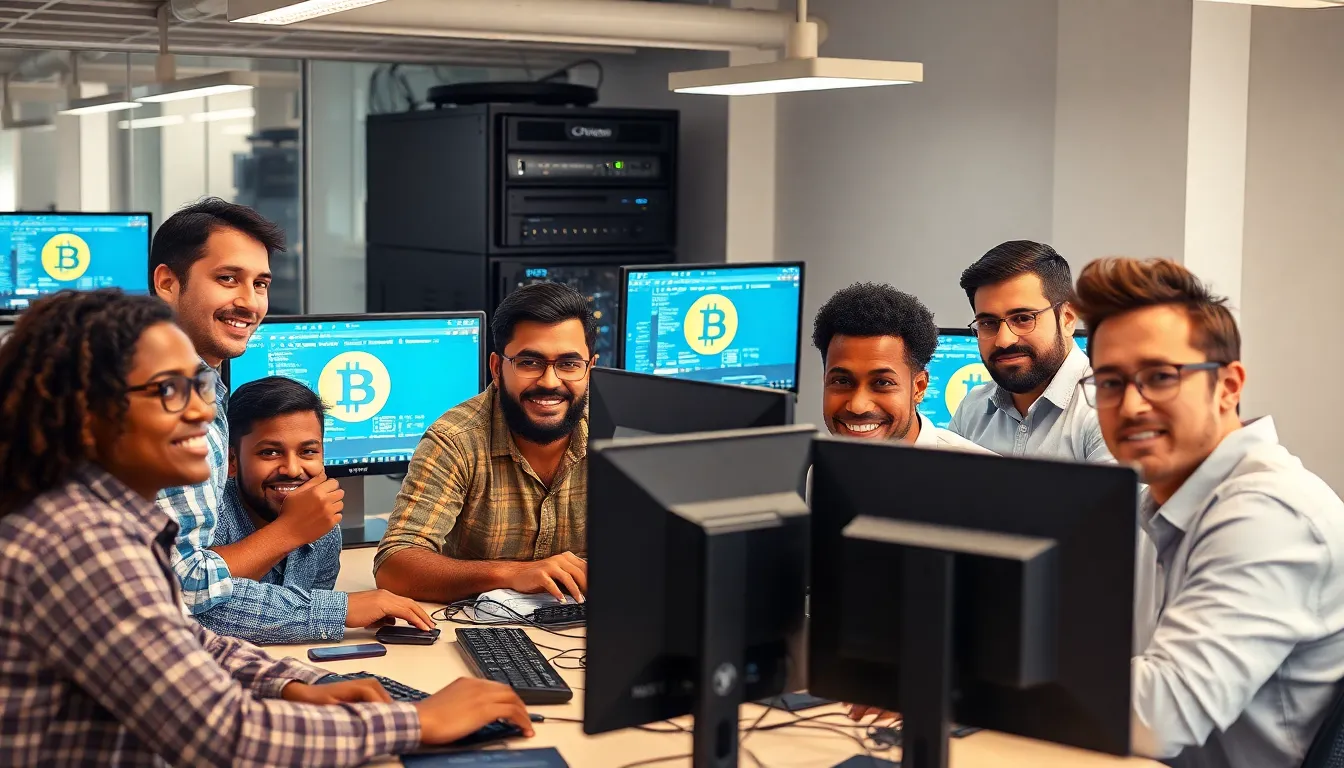Bitcoin mining has become a buzzword in the world of digital currencies, drawing in enthusiasts and investors alike. This complex process involves validating transactions and adding them to the blockchain, all while earning new bitcoins as a reward. With its allure of profit and technological intrigue, many are eager to dive into the world of mining.
Understanding how to mine for bitcoin is essential for anyone looking to participate in this decentralized economy. It requires not only the right hardware and software but also a grasp of the underlying principles that govern this unique digital currency. As the demand for bitcoin continues to soar, so does the need for knowledge on how to effectively mine and maximize returns.
Understanding Bitcoin Mining
Bitcoin mining is a critical process that involves validating transactions and adding them to the blockchain. It requires specialized hardware and software to efficiently solve complex cryptographic problems.
What Is Bitcoin Mining?
Bitcoin mining refers to the method by which transactions are verified and added to the public ledger known as the blockchain. Miners use powerful computers to solve mathematical puzzles, or hashes, which validate the transactions. When miners successfully complete these calculations, they create new blocks that contain transaction data and are linked to the previous blocks chronologically. In return for their efforts, miners receive newly minted bitcoins and transaction fees. This process secures the network, ensuring reliability and immutability of the data.
The Importance of Mining in the Bitcoin Network
Mining plays a vital role in the Bitcoin network’s operation. It provides security by preventing double spending and maintaining the integrity of the blockchain. Miners validate transactions by confirming that the sender has sufficient funds to complete a transaction and that these funds haven’t been previously used. Furthermore, mining ensures decentralization, as numerous miners worldwide participate in the validation process. This competitiveness among miners contributes to the stability and reliability of Bitcoin, fostering trust among users and enhancing the overall ecosystem.
Types of Bitcoin Mining

Bitcoin mining can occur through various methods, each offering distinct advantages and challenges. The primary types include solo mining, pool mining, and cloud mining.
Solo Mining
Solo mining involves a miner operating independently, using personal hardware to solve cryptographic puzzles. This method yields the entire block reward, currently set at 6.25 bitcoins, upon successfully mining a block. However, solo miners face lower success rates due to the competition from larger mining pools and farms, which dominate the network’s computational power. As such, solo mining suits those with significant resources and expertise who can afford to invest in high-performance hardware.
Pool Mining
Pool mining allows multiple miners to collaborate and combine their computational power, increasing the likelihood of solving a block. Participants in a mining pool receive portions of the block reward, distributed based on their contributed processing power. This method leads to more consistent earnings compared to solo mining. Many mining pools also provide additional resources, such as analytics and support, enhancing the overall experience for participants. Popular pools include Slush Pool and F2Pool, which serve miners with varying skill levels and hardware capacities.
Cloud Mining
Cloud mining enables users to rent computational power from a remote data center, eliminating the need for individual hardware setups. Participants pay for the service, receiving a share of the mined bitcoins proportional to their investment. This method appeals to those lacking technical skills or the ability to maintain mining equipment. While it reduces hardware costs and associated energy expenses, prospective cloud miners should carefully research providers to avoid potential scams and ensure profitability.
The Mining Process
Understanding the mining process is essential for effectively engaging in Bitcoin mining. This includes setting up hardware, installing software, and considering collaboration options like mining pools.
Setting Up Your Mining Hardware
Selecting the right hardware is crucial for successful mining. Miners often choose between ASIC (Application-Specific Integrated Circuit) miners, which provide high efficiency, or more general-purpose hardware like GPUs (Graphics Processing Units). Each offers different levels of hashing power and energy consumption. It’s vital to assess factors such as initial costs, electricity rates, and mining difficulty when choosing hardware. Proper cooling and ventilation ensure optimal performance and longevity of equipment.
Installing Mining Software
Installing reliable mining software follows hardware setup. Popular options include CGMiner, BFGMiner, and EasyMiner, each catering to different skill levels and preferences. Miners connect their hardware to the Bitcoin network through this software, enabling the mining process. Configuration settings must align with the chosen mining method, whether solo or pool mining. Regular updates and optimizations enhance mining efficiency and profitability.
Joining a Mining Pool
Joining a mining pool increases the chances of earning bitcoins consistently. Pools allow miners to combine their computational power, solving blocks more efficiently and distributing rewards based on individual contributions. Researching pools for fees, payout structures, and reputation aids in selecting the right one. Popular pools like AntPool or Slush Pool offer diverse features and community support, allowing miners to share resources while improving overall success rates.
Profitability of Bitcoin Mining
Profitability in Bitcoin mining depends on several dynamic factors that can fluctuate based on market conditions and individual circumstances. Understanding these factors allows miners to make informed decisions to maximize their returns.
Factors Affecting Profitability
- Hardware Efficiency: Mining with efficient equipment, like ASIC miners, significantly boosts profitability. ASIC miners provide higher hash rates while consuming less electricity compared to traditional GPUs.
- Electricity Costs: Miners incur significant costs from electricity consumption. Lower rates lead to higher profit margins, making geographic location a critical factor. Miners in regions with cheap energy sources tend to have higher profitability.
- Mining Difficulty: The Bitcoin network adjusts the mining difficulty every 2016 blocks, based on total computing power. Increased difficulty reduces the chances of solving a block, directly impacting profitability.
- Bitcoin Price: Market volatility influences earnings. Higher Bitcoin prices lead to increased revenues per mined coin, while downturns can erase profits and result in losses.
- Pool Fees: Collaboration in mining pools leads to more consistent payouts but involves fees. These fees can reduce earnings, so miners should compare pool options carefully.
- Transaction Fees: Fees associated with transactions included in mined blocks contribute to overall earnings. Higher network activity can increase fees, enhancing profitability.
Calculating Potential Earnings
Miners can estimate their potential profitability through a straightforward calculation involving several key variables. The formula typically incorporates hash rate, electricity costs, block reward, mining difficulty, and pool fees.
- Determine Hash Rate: Measure the miner’s hash rate in terahashes per second (TH/s). Higher hash rates directly increase chances for block discovery.
- Input Current Difficulty: Use the current mining difficulty from a Bitcoin block explorer. This measure indicates how hard it is to find a block.
- Account for Block Reward: As of 2023, the block reward is 6.25 bitcoins per block.
- Factor in Electricity Costs: Calculate electricity costs per kilowatt-hour (kWh) and total wattage of mining equipment.
- Estimate Transaction Fees: Average transaction fees can vary, but including them in earnings estimates is crucial for accuracy.
This formula allows miners to generate an estimate of daily profits, taking into account all critical factors. Using online profitability calculators can simplify this process, providing quick insights into potential earnings.
Environmental Impact of Bitcoin Mining
Bitcoin mining has raised significant environmental concerns, primarily due to its high energy consumption and carbon footprint. As the popularity of Bitcoin continues to grow, understanding its environmental implications becomes crucial.
Energy Consumption Concerns
Energy consumption in Bitcoin mining is substantial. Estimates indicate that Bitcoin mining consumes approximately 100 Terawatt-hours (TWh) annually, comparable to the energy usage of entire countries like the Netherlands. This high demand leads to increased electricity generation, often derived from fossil fuels, which contributes to greenhouse gas emissions. Regions with cheaper electricity, commonly reliant on coal, tend to attract miners, exacerbating pollution and climate change issues. Stakeholders emphasize the urgent need for transparent energy consumption disclosures to address these concerns and facilitate more informed discussions on the mining industry’s environmental impacts.
Sustainable Alternatives
Sustainable alternatives to traditional Bitcoin mining methods exist. Miners can turn to renewable energy sources, such as solar, wind, and hydroelectric power, to reduce the carbon footprint. Some mining operations utilize excess energy produced during off-peak times, enhancing efficiency without straining power grids. Additionally, innovations in mining hardware focus on energy efficiency, with next-generation ASIC miners offering significantly lower power consumption compared to their predecessors. Transitioning to these sustainable practices not only mitigates environmental impacts but also positions Bitcoin mining as a more responsible and eco-friendly endeavor.
Bitcoin mining presents both opportunities and challenges for those looking to participate in the cryptocurrency ecosystem. Understanding the intricacies of mining—from hardware selection to energy consumption—is crucial for success. As the landscape evolves with increasing demand for Bitcoin, miners must stay informed about effective strategies and sustainable practices.
By leveraging the right tools and methods, individuals can maximize their returns while contributing to a secure and decentralized network. With ongoing advancements in technology and a growing emphasis on environmental responsibility, Bitcoin mining can continue to thrive as a viable and responsible venture for the future.





